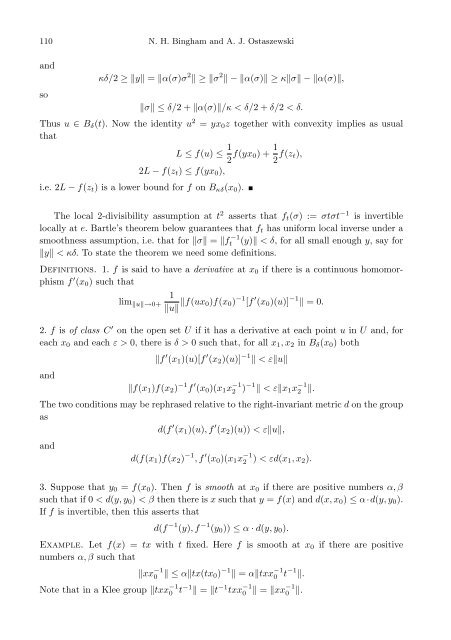Normed versus topological groups: Dichotomy and duality
Normed versus topological groups: Dichotomy and duality
Normed versus topological groups: Dichotomy and duality
You also want an ePaper? Increase the reach of your titles
YUMPU automatically turns print PDFs into web optimized ePapers that Google loves.
110 N. H. Bingham <strong>and</strong> A. J. Ostaszewski<strong>and</strong>soκδ/2 ≥ ‖y‖ = ‖α(σ)σ 2 ‖ ≥ ‖σ 2 ‖ − ‖α(σ)‖ ≥ κ‖σ‖ − ‖α(σ)‖,‖σ‖ ≤ δ/2 + ‖α(σ)‖/κ < δ/2 + δ/2 < δ.Thus u ∈ B δ (t). Now the identity u 2 = yx 0 z together with convexity implies as usualthatL ≤ f(u) ≤ 1 2 f(yx 0) + 1 2 f(z t),2L − f(z t ) ≤ f(yx 0 ),i.e. 2L − f(z t ) is a lower bound for f on B κδ (x 0 ).The local 2-divisibility assumption at t 2 asserts that f t (σ) := σtσt −1 is invertiblelocally at e. Bartle’s theorem below guarantees that f t has uniform local inverse under asmoothness assumption, i.e. that for ‖σ‖ = ‖ft−1 (y)‖ < δ, for all small enough y, say for‖y‖ < κδ. To state the theorem we need some definitions.Definitions. 1. f is said to have a derivative at x 0 if there is a continuous homomorphismf ′ (x 0 ) such thatlim ‖u‖→0+1‖u‖ ‖f(ux 0)f(x 0 ) −1 [f ′ (x 0 )(u)] −1 ‖ = 0.2. f is of class C ′ on the open set U if it has a derivative at each point u in U <strong>and</strong>, foreach x 0 <strong>and</strong> each ε > 0, there is δ > 0 such that, for all x 1 , x 2 in B δ (x 0 ) both<strong>and</strong>‖f ′ (x 1 )(u)[f ′ (x 2 )(u)] −1 ‖ < ε‖u‖‖f(x 1 )f(x 2 ) −1 f ′ (x 0 )(x 1 x −12 )−1 ‖ < ε‖x 1 x −12 ‖.The two conditions may be rephrased relative to the right-invariant metric d on the groupasd(f ′ (x 1 )(u), f ′ (x 2 )(u)) < ε‖u‖,<strong>and</strong>d(f(x 1 )f(x 2 ) −1 , f ′ (x 0 )(x 1 x −12 ) < εd(x 1, x 2 ).3. Suppose that y 0 = f(x 0 ). Then f is smooth at x 0 if there are positive numbers α, βsuch that if 0 < d(y, y 0 ) < β then there is x such that y = f(x) <strong>and</strong> d(x, x 0 ) ≤ α·d(y, y 0 ).If f is invertible, then this asserts thatd(f −1 (y), f −1 (y 0 )) ≤ α · d(y, y 0 ).Example. Let f(x) = tx with t fixed. Here f is smooth at x 0 if there are positivenumbers α, β such that‖xx −10 ‖ ≤ α‖tx(tx 0) −1 ‖ = α‖txx −10 t−1 ‖.Note that in a Klee group ‖txx −10 t−1 ‖ = ‖t −1 txx −10 ‖ = ‖xx−1 0 ‖.
















